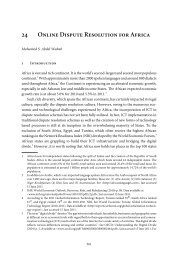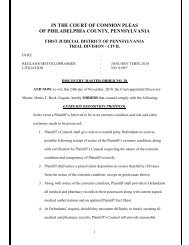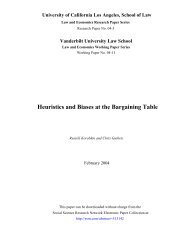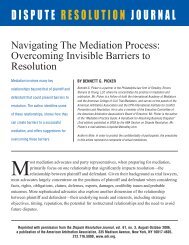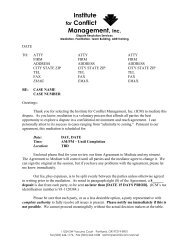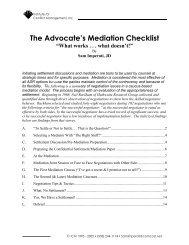17 e-Mediation - Mediate.com
17 e-Mediation - Mediate.com
17 e-Mediation - Mediate.com
Create successful ePaper yourself
Turn your PDF publications into a flip-book with our unique Google optimized e-Paper software.
Noam Ebner<br />
– Have parties participated in the past in e-mediation?<br />
Even one positive answer to these questions is likely to tilt the scales in favor of e-mediation,<br />
providing mediation is a suitable process in the first place. 39<br />
3.3.4 Preconditions for E-<strong>Mediation</strong><br />
The previous section describes considerations likely to make choice of e-mediation beneficial.<br />
However, e-mediation cannot take place unless certain preconditions are met:<br />
– Parties and mediator must have regular access to internet and <strong>com</strong>puters. This may<br />
seem anachronistic to many readers who are so welded to their laptop that they are<br />
virtually cyborgs; however, this is not true in many areas in the world and other situations<br />
– such as weather conditions or travel – can affect anyone.<br />
– Parties must be <strong>com</strong>petent and <strong>com</strong>fortable with technology of the type the mediator<br />
proposes to employ. While the former issue can be directly affected by training, and<br />
this affects the latter, it is hard to directly affect a party’s dis<strong>com</strong>fort with an online<br />
medium; in some cases, this might rule out e-mediation.<br />
– A shared language or adequate online translation services.<br />
– A contextually suitable degree of privacy and security. 40<br />
3.3.5 Choice of Technology<br />
As Colin Rule 41 put it, “Technology, like stage lighting for a play, should not be the focus.<br />
If people walk out of a play talking about the stage lighting then odds are either the play<br />
or the lighting was not a success.” Behind the scenes of every play, though, hours can go<br />
into discussing the placing of every light bulb and fog machine, often trying to figure out<br />
how to render the sources invisible and natural, letting the viewers focus on the actors.<br />
Indeed, the ODR field has seen examples of entities getting lost in their technology and<br />
paying a price. It has also seen examples of constantly adapting technology to suit users’<br />
<strong>com</strong>fort zones and capabilities in a world setting all these in constant flux.<br />
While one could fill an entire chapter describing the nuances of different technologies<br />
that could be used for ODR, this section will avoid that, heeding another of Rule’s admonitions:<br />
anything written about technology is certain to look silly (or, at best, quaint) after<br />
two or three years. Many pages in the ODR literature, and the wider literature on <strong>com</strong>putertion%20Report%20Final%20June%2030.pdf>,<br />
last accessed 11 January 2011. Also see S. Rogers, “Online<br />
Dispute Resolution: An Option for <strong>Mediation</strong> in the Midst of Gendered Violence”, Ohio St. J. on Disp. Resol.<br />
(2008) 24, regarding restorative-justice oriented processes in cases of gender-based violence.<br />
39 For further discussion of this issue, see S. Summers Raines, “The Practice of <strong>Mediation</strong> Online: Techniques<br />
to Use or Avoid when Mediating in Cyberspace”, The Third Annual Forum on Online Dispute Resolution,<br />
Melbourne, Australia 2004; Ponte & Cavenagh (2005); Getz (2010).<br />
40 Summers Raines (2004).<br />
41 Rule (2002), p. 245.<br />
380



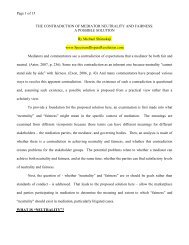
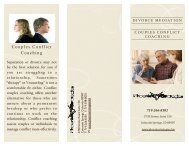
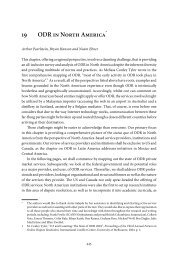
![Settlement Agreement Form [Agreement] - Mediate.com](https://img.yumpu.com/50682143/1/190x245/settlement-agreement-form-agreement-mediatecom.jpg?quality=85)

